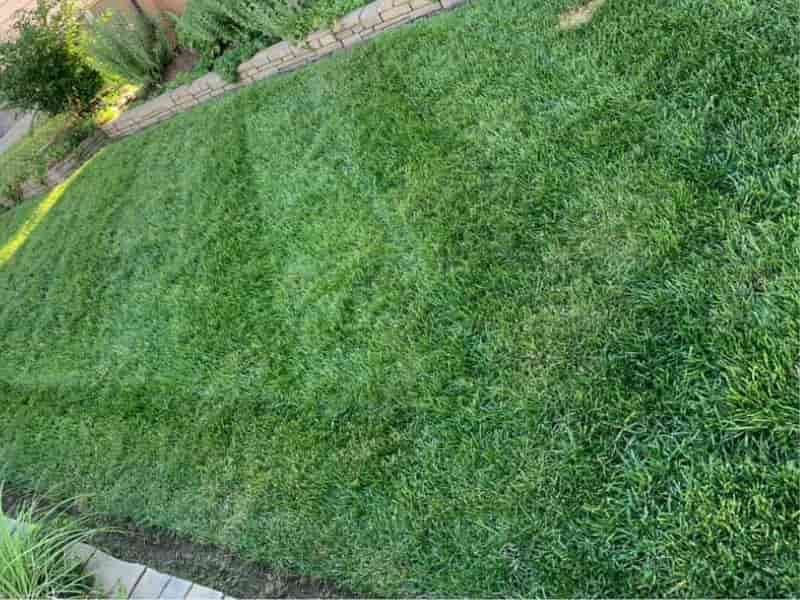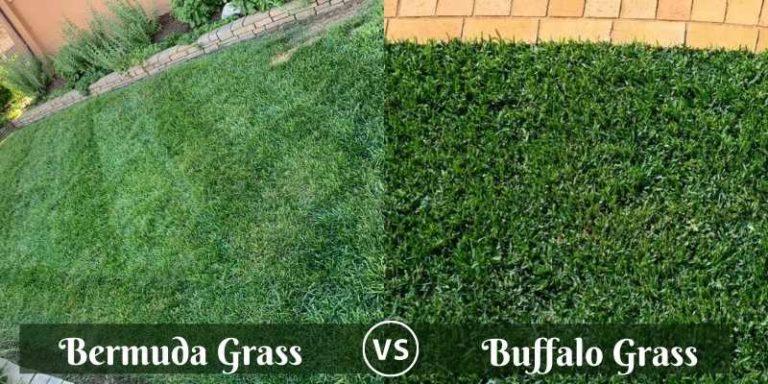When to Overseed Bermuda Grass: How to, Timing + Grass Mixes
There are two major reasons why overseeding a Bermuda grass lawn may be necessary: if the lawn is thin, or if you can’t stand the burnt-out appearance of brown Bermuda grass during the winter season when it goes dormant. Whatever the reason, when should you overseed bermudagrass?
The best time to overseed a Bermuda grass lawn is in the spring if you’re overseeding with warm-season grass like Zoysia. If you are overseeding with cool-season grass seed, the best time is in the fall. The timing is important for a better grass seed germination rate.
You can overseed a Bermudagrass lawn with either a warm-season grass seed or a cool-season turfgrass, depending on what you’re looking to achieve. I’ve elaborated in detail on what you’ll need to do to get your grass to grow thick and greener again.
Table of Contents
Should you overseed Bermuda grass?
Overseeding Bermuda grass helps the grass grow into a thick, lush lawn as the new grass fills up bare patches for a fuller appearance. In addition, Bermuda grass is a warm-season grass that goes dormant during the colder seasons, so, overseeding it with a cool-season grass will help your lawn remain green throughout the year.
Overseeding and maintaining a thick lawn also helps control stubborn weeds like crabgrass, the thick turf crowds out weeds that compete with the desired grass species.
In addition, if your lawn is established in a shaded area, you might want to overseed with a sun and shade mix of grass seed because Bermuda grass grows thin and sparse under shade. Overseeding will help the turf grow full in those shaded spots.
Here are a few shade-tolerant varieties you can oversee Bermuda lawns with.
When to overseed Bermuda grass?
The recommended time to overseed Bermuda grass is in the spring, which is the peak of the growing season. The warm soil temperature will increase the seed germination rate as opposed to when temperatures are cool. However, you can overseed in the fall if you are overseeding with a cool-season grass seed.
You may be tempted to overseed your Bermuda grass lawn as soon as you notice signs of thinning out. However, the best approach would be to wait until its peak growing season for the type of turfgrass seed you are using for the process.
| Overseeding with… | Best time to overseed |
| Warm-season grass | Spring – in the warm temperatures. |
| Cool-season grass | Fall to winter when temperatures are cool. |
Overseeding bermuda grass with a warm-season grass
For warm-season turfgrasses like Bermudagrass, the peak growth and germination season is usually in the spring. At this time, soil temperature conditions are usually prime for the germination of grass seed. Planting earlier or later than this peak growth window can lead to slower germination.
If you’re overseeding your Bermuda lawn with a warm-season turfgrass, you’ll want to avoid doing so in winter; as the frosty and chilly conditions can kill grass seeds.
Overseeding bermuda grass with a cool-season grass
However, if you’re overseeding the lawn with a cool-season turfgrass to avoid winter browning, you can do so during fall or winter.
What to overseed Bermuda grass with
You can overseed Bermuda grass with either a cool-season or a warm-season grass, or even a mix of both. It all depends on the reason for overseeding.

Here are the best grasses to overseed Bermuda grass with:
Zoysia
If your Bermuda grass lawn is thinning out due to partial shading, you can make the turf denser and greener by overseeding with Zoysia grass. While both are warm-season turfgrasses, Zoysia grass has a better shade tolerance than Bermuda grass and will thrive even in partially shaded lawns.
What’s more, Zoysia is a relatively low-maintenance turfgrass variety, being as it’s both drought-tolerant and wear-resistant. However, it’s vulnerable to pest infestation. Overseeding a Bermuda grass lawn with zoysia can improve your lawn’s hardiness in general.
Fescue
Overseeding Bermuda grass lawns with fescue grass can be quite challenging since fescue grows vertically as opposed to lateral growth. This is contrary to Bermuda grass, which grows sideways through stolons and rhizomes for a thicker appearance. As such, you’ll have a problem deciding whether to mow low for improved lateral growth or mow high for enhanced vertical growth.
Nevertheless- fescue is still a cool-season grass and will fix the browning of your dormant Bermuda grass during the colder seasons. Another reason to overseed with fescue is that it typically dies back from early spring, reducing competition for resources with your Bermuda grass.
Hybrid Bermuda grass
If your Bermuda turf is thinning out due to wear, you can restore its fuller appearance by overseeding with a hybrid Bermuda grass variety. Such hybrid grass species typically boast increased wear tolerance.
If you had overseeded the lawn with annual or perennial ryegrass during the colder seasons and are now witnessing a Bermuda decline due to the same, you can re-establish your Bermuda base by overseeding with hybrid Bermuda grass varieties.
Annual Ryegrass
Annual ryegrass is the best cool-season grass to overseed Bermuda grass with, as it dies back faster than fescue in the spring, preventing competition with your Bermuda turf. To overseed your Bermuda lawn with annual ryegrass for a lawn that stays green even during winter, consider the tips below:
- Scalp your Bermuda Grass
As Bermuda grass goes dormant, scalp it before overseeding the lawn with ryegrass. Scalping opens up the lawn for enhanced seed-soil contact. To do so, lower your mower height to its lowest setting. This will ensure that the mower blades cut the browning Bermuda grass as close to the ground as possible.
- Apply Ryegrass Seed
After scalping your lawn and removing all grass clippings, you should proceed to overseed your Bermuda lawn with annual ryegrass at a rate of 1.5 pounds of seed for every 1000 square feet. To ensure uniform seed distribution across the lawn area, you can use a lawn seeder.
- Mulch and Irrigate post-overseeding
After overseeding your Bermuda lawn, apply organic mulching and then turn on your water sprinkler. The mulching will help to keep the annual ryegrass seeds moist. We recommend irrigating lightly multiple times per day, as it’s crucial to keep the seeds moist until germination occurs.
Perennial Ryegrass
Another good winter cover grass for your Bermuda turf would be perennial ryegrass, as you can easily cut it back in spring as Bermuda grass is about to grow back. Perennial grass stays green and wear-tolerant in winter as Bermuda grass lies dormant.
To properly overseed your Bermuda lawn with perennial ryegrass, I recommend applying 15 pounds of seed for every 1000 square feet of lawn area.
Use a lawn seeder when overseeding your Bermuda lawn with Bermuda grass, as this will encourage uniform growth. Slit-seeding, aero-seeding, and broadcasting- on the other hand- are not recommended, as you may end up with random, unsightly perennial ryegrass growth patterns.
To properly care for the perennial ryegrass after overseeding to encourage germination and greening, you should apply topdressing and fertilizer. It’s advisable to apply about a quarter inch of topdressing, such as sand or compost to speed up growth.
Meanwhile, a starter fertilizer not only boosts the growth and development of the perennial ryegrass but also speeds up the recovery rate of your Bermuda turfgrass once spring comes around.
How to overseed a Bermuda grass lawn
Before overseeding your Bermuda grass lawn with a cool-season turfgrass, it’s important to consider how long the grass will take to die out once the warm season resumes.
For instance, Kentucky bluegrass tends to last too long into the summer and wouldn’t be a good candidate for overseeding. Annual ryegrass- on the other hand- tends to die out as soon as the warm season returns in early spring.

Choose the grass seed to use for overseeding properly and then go ahead to overseed at the right time.
Here’s how:
1. Cut out pre-emergent application
Stop applying pre-emergent herbicides at least three months before you overseed, as the weed killer will kill off your new seedlings as well.
2. Check the soil temperature
Overseed at a time when soil temperature has dropped below 70 degrees Fahrenheit.
3. Mow low and rake the lawn
Mow the lawn at a height of one inch before overseeding. Also, rake the lawn to ensure increased contact between the grass seeds and the soil once you start sowing. Such proper lawn preparation is necessary if you want to increase your chances of ending up with a thicker, fuller turf.
4. Spread grass seed over the lawn
Overseed the lawn by sowing between 6-8 pounds of grass seed for every 1000 square feet of lawn area. Sowing should be succeeded by watering and application of a nitrogen fertilizer to facilitate faster germination.
5. Resume mowing after a month
Once your new grass seedlings have grown to a height of about 2.5 inches, you can resume mowing. This is usually at about the one-month mark post-overseeding. Continue mowing the turf every two to three days.
Pro tip: For Bermuda lawns that undergo heavy foot traffic, using a sand mix topdressing helps to speed up the rate of turf establishment for the newly planted seeds.
Can you overseed in the fall?
Overseeding in the fall is not recommended because the low temperatures usually inhibit seed germination. Ideally, you should overseed in spring while it’s warm. However, when overseeding with a cool-season turfgrass like annual ryegrass, do so in early fall to give the grass seeds a chance to grow and for the turf to become established by mid-winter.
Early fall, from September through October, makes for a good middle ground, as the temperatures are usually till relatively higher at this time of the year, as opposed to late fall and winter when conditions are frosty.
When to mow after overseeding
It is recommended to wait for about a month post-overseeding to mow your lawn. However, depending on the rate of seedling germination, you may reduce this duration by about two weeks
After the first mowing post-overseeding, you should schedule subsequent mowings at 3-4 day intervals. The ideal mowing height for Bermuda grass is 0.5 inches. If you mow any lower than that – say one inch – it would be advisable to mow more frequently.
References
- Tom Samples, Professor, and John Sorochan, Associate Professor Plant Sciences, Tennessee State University Extension: Overseeding Bermudagrass with Perennial Ryegrass
- Rick Gibson, Extension Agent, Agriculture, Arizona State University Pinal County Cooperative Extension: Overseeding Bermudagrass Lawns with Annual Ryegrass



